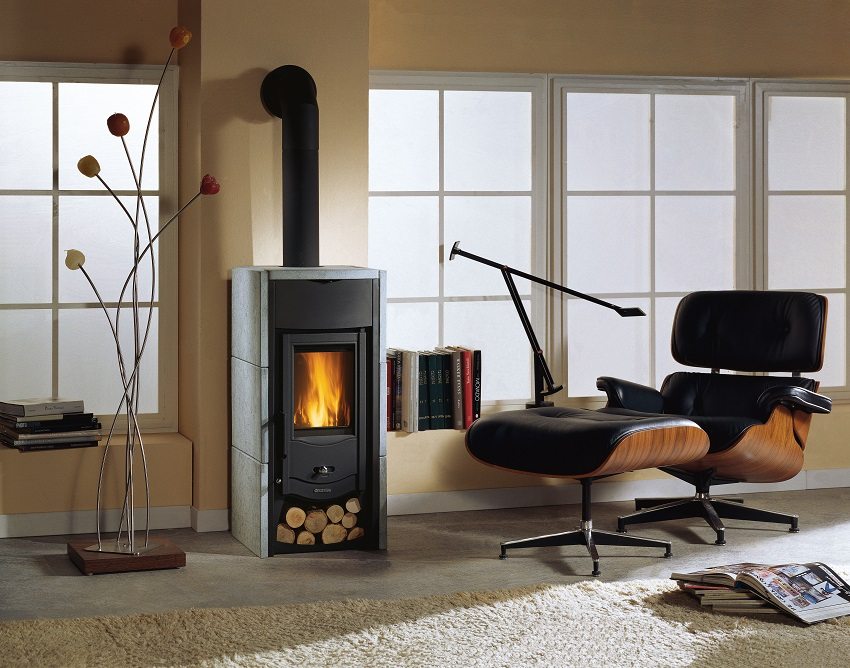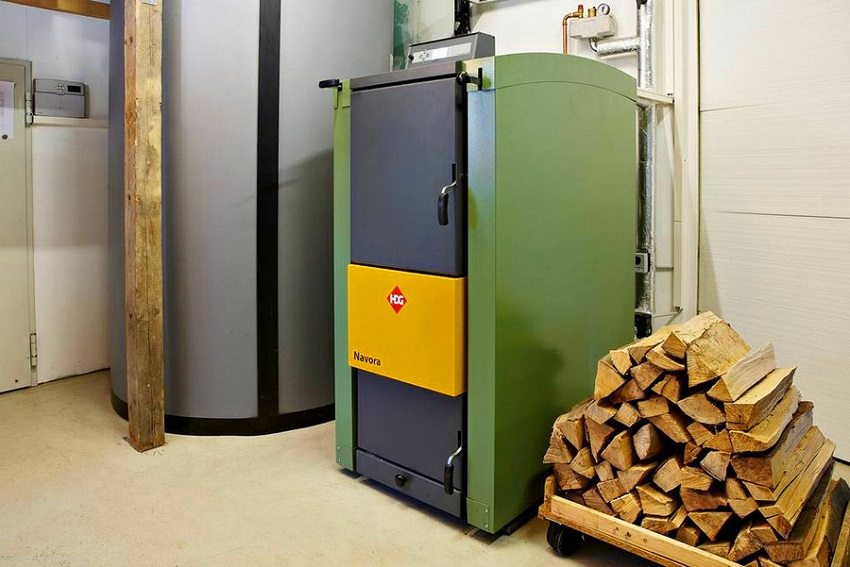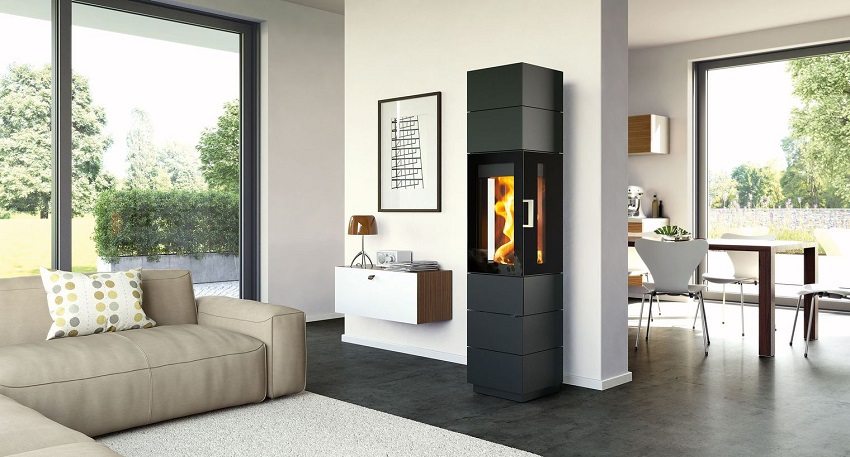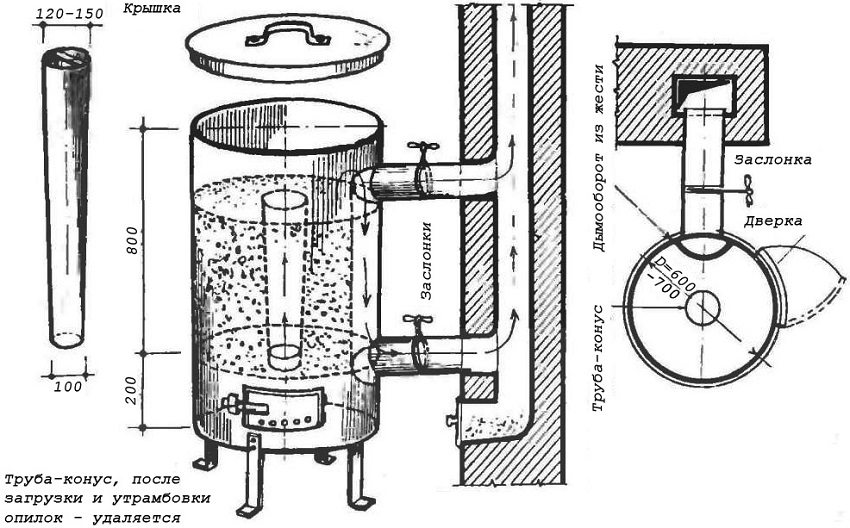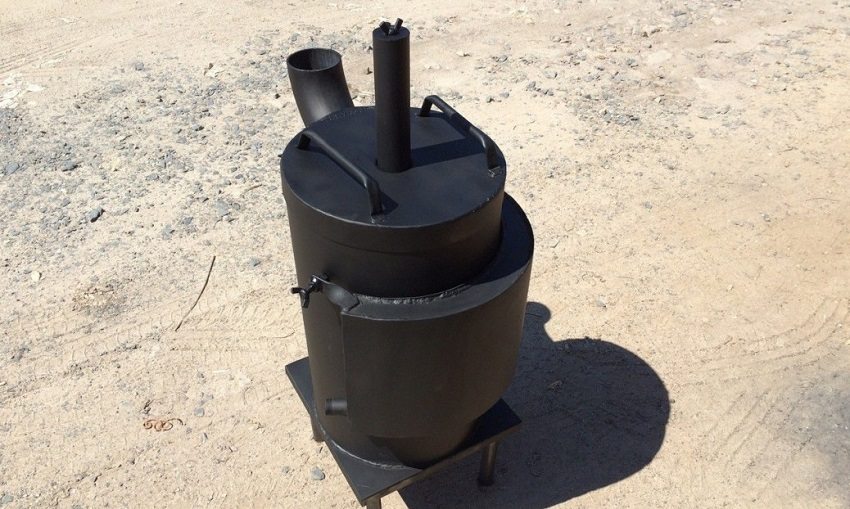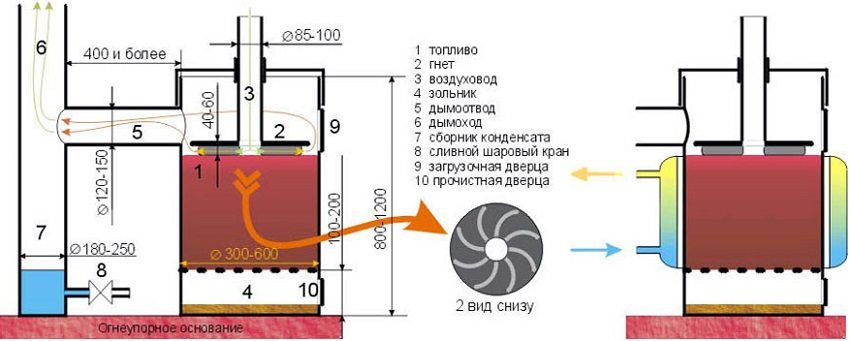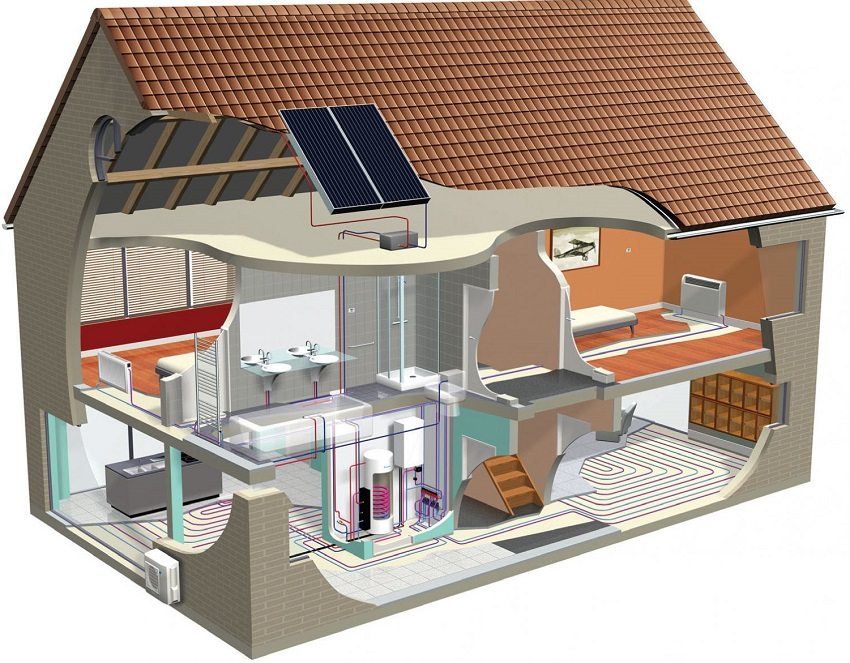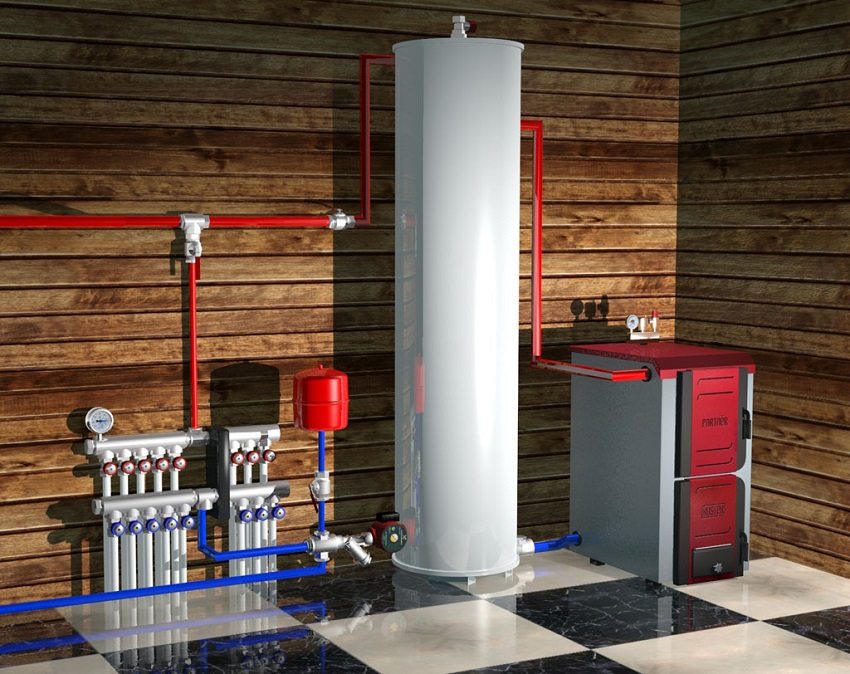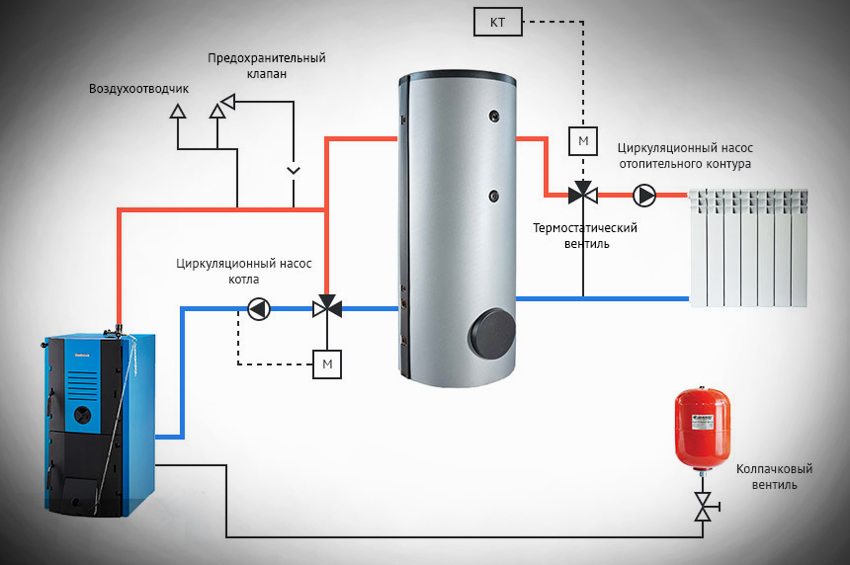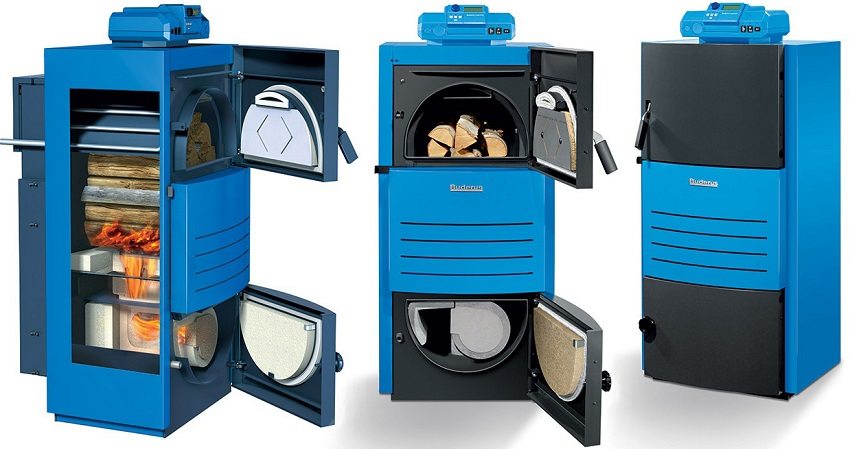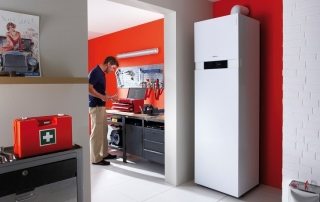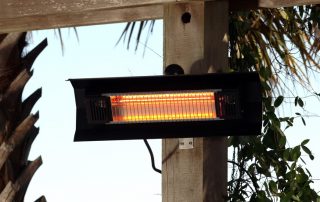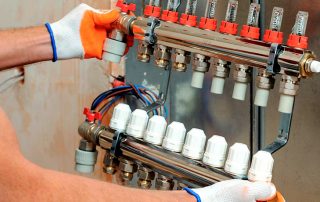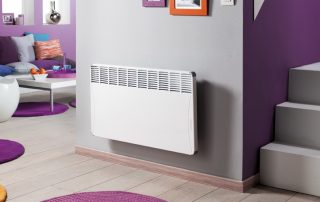A solid fuel wood-fired boiler with a water circuit is installed in a house with permanent residence of people. The period between fuel inserts of a classic unit does not exceed 4 ÷ 8 hours. A working boiler is not left unattended. Do-it-yourself modernized long-burning boilers on wood allow you to change the heating time, loading 24 hours is the optimal period of operation of the unit without intermediate fuel loading.
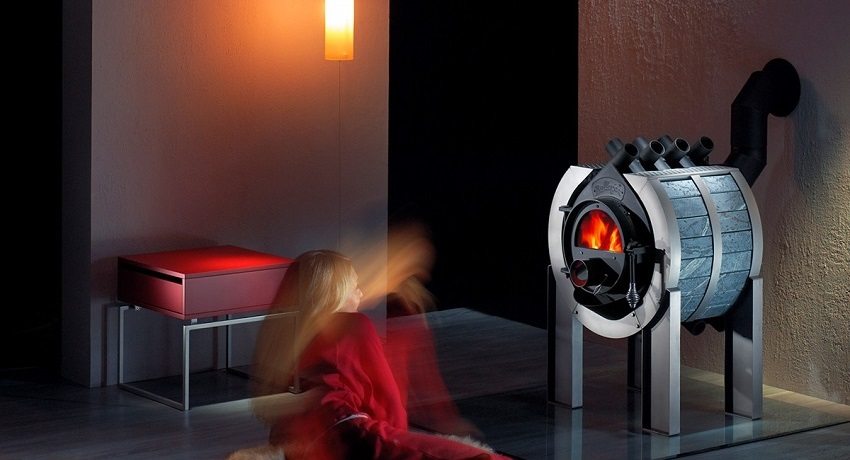
Solid fuel boiler for heating domestic and industrial premises
Content [Hide]
Solid fuel boilers for heating a private house
Basic models of long-burning boilers with a water circuit on wood for the home are distinguished by the material of manufacture, the design of the furnace, heat exchanger, chimney, and the method of loading and burning fuel.
A long-burning wood-fired boiler with a water circuit is equipped with a tubular (vertical) register or a jacket-type heat exchanger. The case design practically excludes the possibility of water boiling in systems with natural circulation.
A long-burning steel wood-fired boiler for heating a house has a low thermal inertia. The heat-resistant steel boiler circuit withstands sudden changes in temperature and pressure in the system. The lack of material is its sensitivity to corrosion, which is enhanced by the thermal stress of the metal. The overhaul period of the steel unit is 15 years.
The walls of a cast-iron heat exchanger of a wood-burning boiler for heating a private house with batteries heat up and cool down for a long time. The brittle alloy is not designed for critical changes in system performance.
The advantage of cast iron is due to the amorphousness of the material to oxygen corrosion. The service life of a boiler with a cast-iron heat exchanger, with the correct operation of the unit, reaches 25 years.
The principle of operation of a long-term combustion unit is forced, sequential, downward smoldering of wood, in which methane, carbon monoxide and hydrogen are released. Lack of oxygen slows down the speed of flame propagation. Additional heat energy is generated by burning flue gas. The flue gas stream washes the surface of the heat exchanger at the boiler outlet. The design allows loading firewood once a day.
Table 1.The price of long-burning solid fuel boilers:
| Boiler brand (country of origin) | Price, rubles |
| Zota Mix - 32 (Russia) | 38700 |
| Stropuva Mini S8 (Baltics) | 58240 |
| Solid fuel boiler of long burning OPOR N 412 (Czech Republic) | 51731 |
Note! The average price of boilers for long burning on wood for a home is 50 thousand rubles. The quality of the latest domestic developments of solid fuel boilers is a worthy competitor to foreign counterparts.
Long burning pyrolysis boilers
Pyrolysis units are one of the types of long-burning boilers. The staged separation of the combustion process increases the efficiency and extends the operating time of the gasifier. The firebox of the pyrolysis boiler is separated by a special nozzle. In the first compartment, under the influence of high temperatures, laying firewood gives off flammable gas. The second is used for the afterburning of wood decomposition products. A minimum amount of ash is formed in the ash pan, and the chimney is not overgrown with soot deposits.
Gas generating units are intended for heating systems in residential buildings with an area of more than 100 m².
Table 2. Price of long-burning pyrolysis boilers with a water circuit:
| Brand | Price, rubles |
| Solid fuel pyrolysis boiler MS-16 (Russia) | 132000 |
| Steel pyrolysis boiler Buderus Logano S171-22 W (Czech Republic) | 202250 |
| Solid fuel pyrolysis boiler Bourgeois - K STANDART-20 (Russia) | 49800 |
| Gas generator boiler KO12 (Russia) | 52494 |
Wood pyrolysis boilers operate up to two days on one fuel load. The cost of the product depends on the brand of the manufacturer, the power and the degree of equipment of the unit with automation.
Do-it-yourself long-burning boilers on wood, loading 24 hours
The power of the boiler is selected in accordance with the structural characteristics of the house (area, total heat losses) and the climatic zone of the place of residence. As a rule, the efficiency of a home-made boiler for long burning on wood does not exceed 80% (i.e. a fifth of the heat from fuel combustion is lost in the boiler).
Lack of thermal power stimulates the generator to work in intensive combustion mode. Constant peak loads lead to excessive consumption of firewood, double heat loss and premature boiler wear.
Calculation of the dimensions of the furnace for a long burning boiler on wood
The type of wood, the shape and length of the wood determines the size and equivalent area of the combustion chamber. Specific and bulk density of the load, the heat that firewood releases during combustion are reference values. The calculation of the volume of loading will help to calculate the fuel consumption for the season, organize fuel storage places.
Important! The quality of the wood affects the combustion process. The high resin content in softwood firewood and the high moisture content of freshly cut wood reduces the boiler efficiency. Incomplete combustion of raw wood leads to the deposition of soot and tar on the surface of the water circuit, the walls of the furnace and chimney. Metal oxidizes, transfers heat worse, burns out quickly.
Table 3. Volumetric heat of combustion of wood of different species:
| Type of wood (moisture content no more than 20%) | Calorific value, kWh / kg | Specific density of firewood, kg / m³ | Bulk density, kg / dm³ | Combustion temperature, ° С |
| spruce | 4,3 | 450 | 1,4 | 600 |
| Scots pine | 4,3 | 520 | 1,6 | 660 |
| Birch tree | 4,2 | 650 | 1,9 | 890 |
| oak | 4,2 | 720 | 2,0 | 900 |
Consider an example of calculating the volume of the loading chamber of a wood boiler.
Initial data:
- boiler power 10 kW;
- the volume of one load must ensure the operation of the unit during the day;
- fuel - birch firewood, log length 0.60 ÷ 0.65 m;
- moisture content of wood 20%.
Related article:
Heating options for a country house: choosing a boiler. Advantages and disadvantages of water heating from a wood-burning stove. Features of solid fuel, gas, electrical units: description and prices.
When burning 1 kg of birch firewood, 4.2 kW of thermal energy is released. The given power (10 kW) will ensure the burning of 2.4 kg of wood per hour (10 / 4.2 = 2.381).
A cubic meter of birch firewood weighs 650 kg. The hourly fuel consumption will be ≈ 0.004 m³ / h (2.4 / 650 = 0.0037).
The weight of the bookmark that the grate with the nozzle must withstand is ≈ 60 kg (2.381x24 = 57.144).
Birch firewood does not fall tightly, therefore the volume of the bookmark will increase 1.9 times - up to 0.008 m³ / h (0.004x1.9 = 0.0076).
According to the condition - loading once every 24 hours, respectively, the volume of fuel is 0.2 m³ (0.008x24 = 0.192).
If we take into account the length of the logs 0.6 ÷ 0.65 m, then the optimal depth of the firebox will be 0.7 m.
Let us assume the height of the fuel loading is 0.6 m.The width of the furnace is 0.5 m (0.2 / 0.7 / 0.6 = 0.476)
The working size of the firebox of a wood-fired boiler for heating a house (area 80 m2, birch firewood) is 0.7x0.6x0.5 m. flue gas removal.
Regulated and balanced combustion will reduce the rate of natural flame spread. The limited supply of primary and secondary air to the furnace will provide a lack of oxygen and extend the operating time of a home-made boiler by 1.8 times. This can reduce the estimated firewood consumption and, consequently, the size of the unit.
Homemade long-burning wood-fired boiler with vertical firebox (Bubafonya)
Do-it-yourself long-burning boilers are assembled from sheet steel (thickness 4 ÷ 6 mm), thick-walled pipes (DN 300 mm) and cylindrical containers of a suitable size. The simplest design ("Slobozhanka" or "Bubafonya") is assembled from a gas cylinder or barrel. The principle of the device is copied by the Baltic boiler "Stropuva".
The capacity of a vertical firebox is used for burning firewood from top to bottom. The process is accompanied by a uniform compaction of the load, the release and afterburning of wood gases, and the removal of combustion products into the chimney.
The primary air is supplied to the combustion mirror through a vertical pipe. A static or telescopic structure is mounted in the upper wall of the boiler. The piston axis runs along the center of the cylindrical firebox. The gap between the collar and the primary air supply pipe is formed with a welded bead, which provides free stroke of the stem and minimal air leakage into the air chamber for burning wood gases.
Combustion of pyrolysis gases increases the boiler efficiency. A damper cover at the top of the pipe regulates the air intake. A disc with blades is welded at the bottom, which cut the air flow in the combustion zone. The material for the distributor is selected taking into account the heat capacity. The diameter of the disc is slightly smaller than the size of the firebox.
Constructive proportions of the Bubafonya boiler:
- optimal body diameter 300 ÷ 800 mm;
- boiler height - in the range of 3 ÷ 5 diameters;
- wall thickness 4 ÷ 6 mm;
- the diameter of the disc is 10% less than the cross-section of the combustion chamber;
- the thickness of the disk is inversely proportional to the diameter (a heavy pancake will push the combustion zone and extinguish the flame, a light pancake will lead to a reverse combustion effect);
- curved blades form a directed turbulent air flow for burning pyrolysis gases;
- the diameter of the air supply pipe is taken as 0.55 from S (cross-sectional area of the outlet pipe of the chimney);
- the gap between the pipe and the collar does not exceed 2.5 mm;
- the height of the air intake pipe (in the lower position) rises above the collar by 150 mm.
The cross-sectional area of the chimney pipe at the outlet of the long-burning boiler is determined by empirical formulas:
S = 1.75xN (m2)where
S is the cross-sectional area of the outlet pipe (cm² or m²);
N is the heat output of the boiler (kW / h);
1.75 - coefficient obtained empirically (m2h / kW).
N = m * qw (kWh)where
m is the mass of firewood of one load (kg);
qw - specific heat transfer of wood with a certain moisture content (kW / kg).
The weight of the load for self-made boilers for long burning on wood is determined by the working volume of the furnace (Vk) and the specific gravity of wood (md):
m = Vk * md (kg)where
Vk = πD² / (4 * hт) (dm³), where
hт is the height of the loading chamber.
Table 4. Balanced size of elements in the primary air distribution system for the Bubafonya boiler:
| Boiler furnace diameter, mm | Disc thickness, mm | Height of the guide fins of the air distributor, mm |
| 300 | 8-10 | 40 |
| 400 | 6-8 | 50 |
| 600 | 4-6 | 60 |
| 800 | 2,5-4 | 80 |
Note! It is not possible to place the tubular heat exchanger in the combustion chamber. A larger diameter external cylindrical casing or a structure that is built into the chimney is required.
The principle of operation and drawings of pyrolysis boilers with their own hands
Homemade pyrolysis units are installed to heat large houses. The design of the firebox, nozzle and smoke ducts complicates the assembly of homemade gas generators. Forced circulation coolant and air supply to the combustion zone means the dependence of the boiler operation on external factors. To reduce the risk of emergency breakdown of the boiler, a damper for the release of thermal energy and a jacket-type heat exchanger allow.

Diagram of a home-made gas generator with forced air supply to the combustion zone: 1 - boiler body; 2 - loading door; 3 - ash pan door; 4 - a fan supplying air to the combustion zone; 5 - loading chamber and zone of primary fuel combustion; 6 - a technological hole for cleaning the chimney channels; 7 - combustion chamber of wood gases; 8 - heat exchanger jacket; 9 - flue gas outlet channel; 10 - chimney outlet neck; 11 - chimney adjusting gate (11а - gate handle); 12 - outlet to the distribution pipeline; 13 - return pipe through which the cooled coolant flows from the heating system; 14 - sleeve of the control unit (thermomanometer); 15 - Luke for cleaning smoke channels
The boiler body is welded from thick-walled (4 ÷ 5 mm) sheet steel. Loading of firewood is frontal. Thermal radiation is transferred to the boiler roof, side walls of the chamber and heats the air entering the combustion zone. The tightness and tightness of the combustion chamber is ensured by a shutter with a reflector and a swivel bolt on the loading and ash hatches. Air is supplied to the combustion chamber forcibly by a fan.
The shell of the heat exchanger completely covers the furnace and partially the combustion chamber of pyrolysis gases. The gap (3 ÷ 5 cm) is filled with water. The heat exchange of the rear wall is increased: on one side, the heat exchanger borders on the firebox, the other wall of the jacket is in contact with the chimney channel. A heat exchanger built in the direction of the flue gas flow reduces the temperature of the flue gases to 100 ° C. The internal volume of the boiler circuit is taken as 5 ÷ 25% of the total capacity of the heating system.
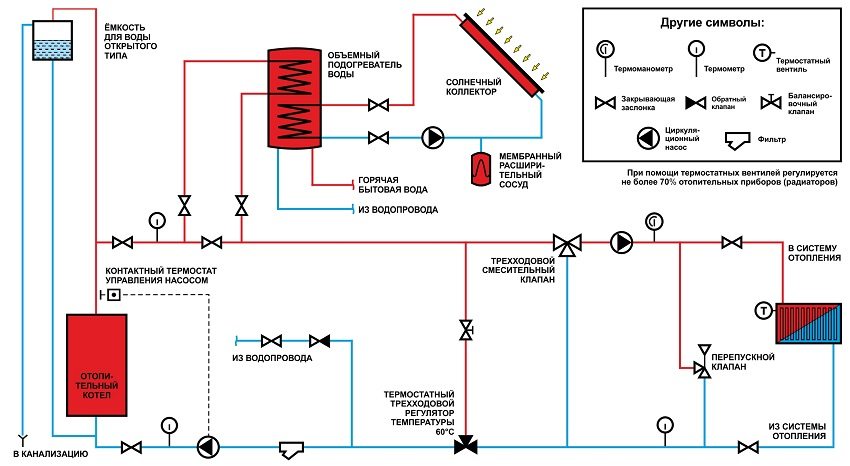
Typical strapping scheme pyrolysis boiler
The coolant supply pipe to the consumer system is located at the top. Return pipe connection - bottom. Cooling of the return heat carrier below 65 ° C is dangerous for acid condensate falling out on the walls of the heat exchanger, which destroys steel. With a low boiler output, the temperature between the flow and return lines is equalized by installing a bypass valve. The boiler circuit of a large house is supplemented with an elevator unit and a circulation pump.
The grate in homemade long-burning boilers serves as a support for the fuel load. Hot firewood lies on the grate, lined with fireclay. The nozzles in the grate body serve as a nozzle through which the combustible gas enters the afterburning zone of the fuel.
Ash and ash wake up in the ash pan. For low-power boilers, with a uniform distribution of the heat load over the mirror, standard cast iron grates are suitable.
The combustion products enter the channels and exit the boiler through the chimney neck (the formula for the cross-sectional area of the chimney neck is given in the example above). The chimney damper is opened if necessary.
The design allows additional loading of fuel without complete extinguishing of the boiler or forced discharge of thermal energy in the event of a power outage. Hot wood gas leaves the furnace bypassing the afterburner and chimney ducts.
The cross-section and height of the chimney provides for the operation of a non-volatile home-made boiler on natural draft. The normal draft of the pyrolysis boiler will be provided by a chimney height of 6 m.
The data obtained are reflected on a scale drawing of a long-burning boiler with their own hands, according to which the volume and approximate amount for the purchase of consumables are determined.
Important! If you cannot figure out the calculation of the boiler parameters yourself, then you should seek the help of professionals. Specialized Internet resources offer drawings for making a long-burning pyrolysis boiler with your own hands. Video tutorials, with detailed installation explanations, are attached to the set of technical documentation.
Installation of wood-fired boilers in the heating system
Self-production of a boiler implies the skills and experience in the production of welding, electrical installation and locksmith work. Knowledge of physics, heat engineering, materials science, rules for installing heating systems will be useful.
Observance of safety techniques and methods is necessary. An equipped room and tools are required to assemble the boiler.
Material for making a pyrolysis boiler:
- sheet steel 6, 5 and 4 mm thick (firebox, heat exchanger jacket and body);
- corner with sides of shelves 50 mm (frame stiffeners);
- steel pipe (piping of a heat exchanger with a heating system);
- a suitable size cast iron grate or round rod with a diameter of 20 mm;
- fireclay brick;
- centrifugal fan;
- ready-made doors with reflector, fastening, handle and lock;
- safety group (temperature sensor, pressure gauge).
The welded parts are marked with chalk (joint, part no., Dimensions). Specialized organizations offer cutting services at the point of purchase.
Boiler making tools:
- DC welding machine;
- electrodes (3 ÷ 5 mm in diameter);
- electric drill;
- angle grinders (for large 230 mm and small 125 mm circle);
- vernier caliper, tape measure, level.
The assembly of the boiler starts from the inner shell. The quality of the welds should ensure the strength and density of the structure, which is in direct contact with the coolant.
Do-it-yourself installation of long-burning boilers on wood
A pyrolysis boiler for an autonomous heating system is located in a separate, specially adapted, fire-protected room. The boiler room is equipped with a ventilation system. The unit must be at least 20 cm away from the walls.
The standard weight value for home-made long-burning boilers on wood is 250 kg / m². Compliance with the condition allows the unit to be installed on a flat, stable surface without a foundation. The area of the installation site is taken out beyond the projection of the unit body by 15 cm (30 cm in front of the fire door).
The floor is covered with asbestos or basalt cardboard (thickness 4 ÷ 6 mm). A sheet of galvanized roofing iron (2 mm thick) is placed on top. Direct contact of the floor with the body excludes supporting structures - boiler legs.
The chimney surface must be covered with thermal insulation. Insulation will prevent a sharp drop in temperature and the formation of condensation in the chimney. The thickness of the insulation layer depends on the temperature of the exhaust flue gases. It is advisable to use a stainless steel sandwich pipe that is resistant to aggressive media. In the absence of natural draft, a smoke exhauster is installed.
The aesthetics of handicraft production is inferior to the design of factory models, but the self-assembled unit meets the requirements of a specific heating system. Do not forget that making a long-burning boiler according to ready-made drawings (video) with your own hands will reduce the cost of its arrangement at least 2 times.
